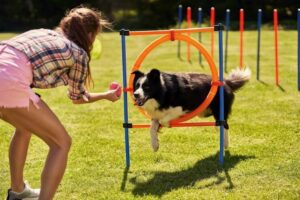Having a dog at home can bring immense joy and companionship, but it can also present challenges, especially when it comes to dealing with destructive behaviors. Scratching furniture, chewing objects, and excessive barking are common problems many owners face.
However, it’s important to understand that these behaviors can be modified with patience, consistency, and proper training techniques.
Identifying the Causes
The first step in dealing with destructive behaviors in dogs is identifying the underlying causes.
These behaviors may result from boredom, separation anxiety, lack of exercise, or even health issues.
Observing the dog’s environment and behavior closely will help determine the root of the problem, allowing for a more targeted approach.
Providing Adequate Mental and Physical Stimulation
Dogs that don’t receive the proper amount of mental and physical stimulation are more likely to develop destructive behaviors.
Make sure to provide toys that challenge your dog’s brain, such as food puzzles, and set aside time for regular physical activities like walks and outdoor play.
A tired dog is less likely to seek out destructive ways to entertain themselves.
Positive Training
Positive training is an effective approach to modifying unwanted behaviors in dogs.
Reinforce desired behaviors positively with rewards such as treats and praise, and avoid scolding or punishing the dog for inappropriate behaviors.
Positive reinforcement creates a positive association between the desired behavior and rewards, encouraging the dog to repeat those actions.
Creating an Adequate Environment
Adapt the home environment to minimize opportunities for destructive behaviors.
Use physical barriers to restrict access to problem areas and provide a designated space with appropriate toys.
Ensure the environment is safe and comfortable for the dog, thus reducing the need for destructive behaviors as a form of stress relief.
Gradual Approach to Solitude
Separation anxiety is a common cause of destructive behaviors.
Gradually train your dog to be alone, starting with short periods and gradually increasing the duration.
Use commands like “stay” and reward calm behavior.
This helps reduce the dog’s anxiety about separation and associate the experience with something positive.
Seeking Professional Help
If destructive behaviors persist or worsen, seeking help from a professional dog trainer may be a sensible option.
Experienced trainers can assess the dog’s behavior, identify specific issues, and provide personalized guidance to address these concerns.
Final Considerations
Dealing with destructive behaviors in dogs requires patience, understanding, and commitment from owners.
Identifying underlying causes, providing adequate stimulation, positive training, creating a conducive environment, and addressing separation anxiety are key strategies.
By adopting a consistent and positive approach, owners can cultivate a healthy and harmonious environment for themselves and their beloved canine companions.




